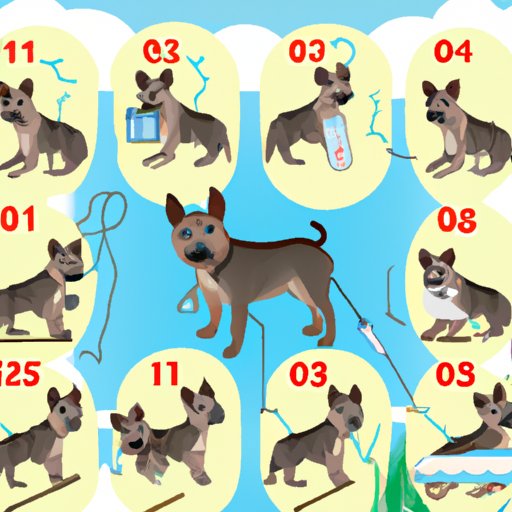Introduction
The labor process in dogs is similar to that of humans: it involves the body preparing for delivery, active labor, and delivery of the puppies. Knowing when your dog is in labor can be challenging, but by understanding the physical signs and changes in behavior, you can better prepare for the birth of your pup’s puppies. In this article, we’ll explore the signs and stages of labor in dogs, as well as how to monitor temperature and vaginal discharge to determine when labor is approaching.
Observing Physical Signs of Labor in Dogs
There are several physical signs to look out for when determining if your dog is in labor. The most obvious sign is a change in her body shape. As the puppies grow and move into position for delivery, your pup’s abdomen will become larger and rounder. Another sign of impending labor is nesting behavior. Your pup may start looking for cozy places to nest, such as under furniture or in a corner of the room. She may also start gathering items, such as blankets and toys, to make her nest more comfortable. As labor approaches, your pup may also lose her appetite.

Understanding the Stages of Dog Labor
Labor in dogs can be broken down into four stages: the prodromal stage, active labor, transition stage, and delivery. During the prodromal stage, which can last up to 24 hours, your pup’s body is preparing for labor. Her temperature may drop and she may experience contractions. During active labor, contractions become stronger and more frequent. During the transition stage, your pup will start pushing out the puppies. Finally, during the delivery stage, the puppies are born one at a time. After each puppy is born, your pup will lick them clean and break the amniotic sac.

Knowing the Duration of Dog Labor
The average length of dog labor is 8-12 hours, but this can vary depending on several factors. The size and number of puppies, the breed of the dog, and the health of the mother can all affect the length of labor. Smaller breeds tend to have shorter labors than larger breeds, while larger litters may take longer to deliver. If your pup has any underlying medical conditions, such as diabetes or heart disease, labor may be longer and more difficult.
Identifying Changes in Behavior During Dog Labor
As labor approaches, your pup’s behavior may change. She may become increasingly restless and may try to hide or isolate herself. Panting is also common as labor progresses, as your pup’s body works hard to push out the puppies. If you notice any of these behaviors, it could be a sign that your pup is getting ready to give birth.
Monitoring Temperature to Determine Labor
Monitoring your pup’s temperature can help you determine when she is going into labor. To do this, you’ll need to take her temperature every few hours using a rectal thermometer. Normal body temperature for a dog is between 100 and 102.5 degrees Fahrenheit. If your pup’s temperature drops below 100 degrees, it could indicate that she is going into labor. However, a temperature drop isn’t always a reliable indicator, so you should also be on the lookout for other signs of labor.

Monitoring Vaginal Discharge During Labor
Another way to tell if your pup is in labor is to monitor her vaginal discharge. As labor approaches, your pup may expel a clear, yellowish fluid called amniotic fluid. This is a sign that labor is imminent. As labor progresses, your pup may also expel a dark, sticky substance called meconium. This indicates that the puppies are close to being born.

Consulting a Veterinarian for Assistance
If you’re not sure whether your pup is in labor or if you’re concerned about her health, it’s best to consult a veterinarian. A vet can help monitor your pup’s labor and provide assistance if needed. It’s a good idea to have a vet present during the birth of the puppies, as they can offer advice on how to care for the newborns and watch for any potential complications.
Conclusion
Knowing when your dog is in labor can be challenging, but by paying close attention to physical signs, changes in behavior, and temperature and vaginal discharge, you can be prepared when the time comes. If you’re ever unsure, consulting a veterinarian is always a good idea. With their help, you can ensure a safe and healthy delivery for your pup and her puppies.
(Note: Is this article not meeting your expectations? Do you have knowledge or insights to share? Unlock new opportunities and expand your reach by joining our authors team. Click Registration to join us and share your expertise with our readers.)
